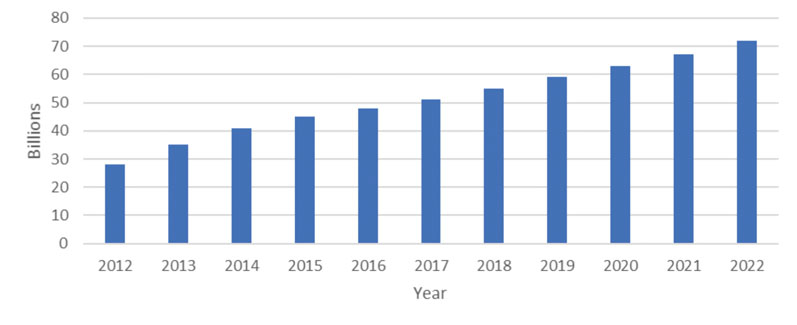One of the most interesting properties of capsules is their ability to be filled with liquids. The geometry of capsules for liquid filling must be different than that of capsules used for more traditional powder-based oral solid dosage forms (Figure 5).
In liquid filling, the capsules are filled, sealed and dried. Because of this, attention must be paid to the gap between the capsule cap and body during the design phase.
This gap cannot be very large, as leakage problems would occur. Conversely, a very small gap is also not desirable, as the internal pressure of the capsule would be very large … and bubbles would appear during the sealing step.
HPMC capsules ensure a proper balance between capsule design and the liquid filling technique. The cap allows a proper air flow once it is placed on the filled body of the capsule.
If the air flow is too low and the capsule cannot breathe properly, the filled capsule can become misshapen prior to banding. This may result in leaking as the band on the capsule might not be uniform.
Within liquid filling, the use of SENDS (self-emulsifying nutraceutical delivery systems) are becoming more and more popular.8,9
These are liquid mixtures in which the ANI (active nutraceutical ingredient) can be mixed with the following additives:
- triglycerides: these vegetable oils are one class of lipids that do not present any safety issues; they can be classified as long chain tryglycerides (LCTs), medium chain triglycerides (MCTs) or short chain triglycerides (SCTs). MCTs are quickly converted in the liver to energy providing ketone bodies such as beta-hydroxy butyrate and acetoacetate, which can be used as energy substitutes for glucose. Studies have documented the benefits of a ketonic diet supplemented with MCTs in weight loss, athletics and energy replenishment.
- cosolvents: to enhance the solubilisation process, this technology uses cosolvents.
- surfactants: these may be water soluble (Cremophor RH 40) or water insoluble (oleate esters).
- other additives: these are additives used to offer protection from oxidation, such as mixed tocopherols and carotenes.
SENDS are used to formulate the ANI in a highly dispersed micellar system, so the dissolution can reach a molecular level that improves its overall solubility in the digestive system.
This ultimately leads to greater absorption, better bioavailability and therapeutic efficacy. Poorly water insoluble ANIs include fat soluble vitamins (A, D, E and K), botanical actives (carotenoids) and other popular nutraceutical supplements.
Examples of these include coenzyme Q10 or CoQ10 (an endogenous cellular antioxidant that is vital for maintaining human health) and quercetin (a flavonoid that exhibits the highest antiradical properties of all the flavonoids). The practically insoluble nature of these ANIs makes them ideal candidates for SENDS formulation.
HPMC capsules are suitable options for filling liquids and SENDS systems with ease. Other types of liquid-fill, such as oils and lipids, which are in liquid state below 35 °C can be easily filled in HPMC capsules. Even semisolid formulations at up to 80 °C can be filled effortlessly.
Promise of stability
Product stability is a particularly important concern in the nutraceutical industry because it affects the overall appeal and aesthetic of the product. The elegant appearance of the product has a profound impact on consumer perception.
In such a scenario, a visually discoloured product can create a wrong impression about the brand and its quality. This challenge is overcome by HPMC capsules as, being devoid of plasticisers and low in moisture content, they do not undergo cross-linking or react with ANIs.
For example, ascorbic acid (vitamin C) was found to be discoloured (brown) in gelatin capsules. However, it was found to be perfectly stable in HPMC capsules — even at accelerated storage conditions (40 °C and 75% RH for 2 months).10
In another study, when the bacterial strain Lactobacillus fermentum CECT 5716 was encapsulated in gelatin and HPMC capsules and stored at both room temperature and 4 °C, it was found that the best viability of the probiotic was observed in HPMC capsules (109 CFU/capsule) at both temperatures.11
The future of HPMC capsules is bright
The nutraceutical industry is a multibillion-dollar market (Figure 6). And, with the incidence of health problems and chronic diseases increasing every day, a substantial number of people are turning to nutraceuticals for a variety of reasons, including a rising trust in them to improve health and prevent chronic diseases, the inability of allopathic medicines to cure chronic diseases, the weak financial conditions of patients and the increasing cost of healthcare, to name a few.

Figure 6: Future global HPMC capsule requirement in billions (2017–2022)
In this light, the nutraceutical market is going to increase tremendously ... as are the challenges associated with nutraceutical products.
Being a very flexible vehicle, HPMC capsules offer an excellent solution to the challenges currently faced by the nutraceutical industry. Apart from their much-desired natural origin, their reduced moisture content, ease of processing, high stability and ability to accommodate various forms of liquid formulations make HPMC capsules a truly viable option.
ACG offers a wide range of HPMC capsules to satisfy every demand, including standard HPMC (vegetarian) capsules, next-gen HPMC (vegetarian) capsules and HPMC (vegetarian) capsules for time-delayed release and for liquid encapsulation. All these capsules maintain a clarity of both appearance and function, which is highly sought by customers and are manufactured in a LEED (Leadership in Energy and Environmental Design)-certified facility.
References
8. J.K. Tillotson, “An Introduction to Self-Emulsifying Nutraceutical Delivery Systems (SENDS),” Tablets and Capsules 15(5), 11–16 (2017).
9. S. Kalepu, et al., “Oral Lipid-Based Drug Delivery Systems — An Overview,” Acta Pharmaceutica Sinica B 3(6), 361-372 (2013).
10. S.B. Majee, D. Avlani and G.R. Biswas, “HPMC as Capsule Shell Material: Physicochemical, Pharmaceutical and Biopharmaceutical Properties,” Int. J. Pharm. Pharm. Sci. 9(10), 1–6 (2017).
11. M. Rodríguez, et al., “Evaluation of Viability of Lactobacillus fermentum CECT 5716 in Gelatin and Gastroresistant Capsules,” J. Pharmacy and Pharmacol. 4, 413–418 (2016).




